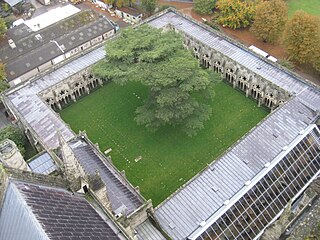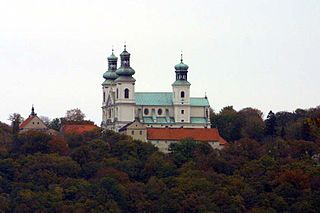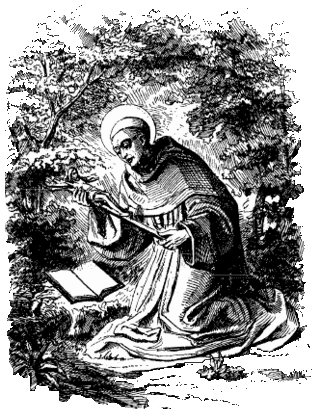
A nun is a woman who vows to dedicate her life to religious service and contemplation, typically living under vows of poverty, chastity, and obedience in the enclosure of a monastery or convent. The term is often used interchangeably with religious sisters who do take simple vows but live an active vocation of prayer and charitable work.

A convent is a community of monks, nuns, friars or religious sisters. Alternatively, convent means the building used by the community. The word is particularly used in the Catholic Church, Lutheran churches, and the Anglican Communion.

A cloister is a covered walk, open gallery, or open arcade running along the walls of buildings and forming a quadrangle or garth. The attachment of a cloister to a cathedral or church, commonly against a warm southern flank, usually indicates that it is part of a monastic foundation, "forming a continuous and solid architectural barrier... that effectively separates the world of the monks from that of the serfs and workmen, whose lives and works went forward outside and around the cloister."

A monk is a person who practices religious asceticism by living a monastic lifestyle, either alone or with any number of other monks. A monk may be a person who decides to dedicate their life to serving other people and serving God, or to be an ascetic who voluntarily chooses to leave mainstream society and live their life in prayer and contemplation. The concept is ancient and can be seen in many religions and in philosophy.

The Camaldolese Hermits of Mount Corona, commonly called Camaldolese is a monastic order of Pontifical Right for men founded by Saint Romuald. Its name is derived from the Holy Hermitage of Camaldoli, high in the mountains of central Italy, near the city of Arezzo. Its members add the nominal letters E.C.M.C. after their names to indicate their membership in the congregation. Apart from the Roman Catholic monasteries, in recent times ecumenical Christian hermitages with a Camaldolese spirituality have arisen as well.

The Bridgettines, or Birgittines, formally known as the Order of the Most Holy Savior, is a monastic religious order of the Catholic Church founded by Saint Birgitta in 1344 and approved by Pope Urban V in 1370. They follow the Rule of Saint Augustine. There are today several different branches of Bridgettines.

Christian monasticism is the devotional practice of Christians who live ascetic and typically cloistered lives that are dedicated to Christian worship. It began to develop early in the history of the Christian Church, modeled upon scriptural examples and ideals, including those in the Old Testament, but was not mandated as an institution in the scriptures. It has come to be regulated by religious rules and, in modern times, the Canon law of the respective Christian denominations that have forms of monastic living. Those living the monastic life are known by the generic terms monks (men) and nuns (women). The word monk originated from the Greek μοναχός, itself from μόνος meaning 'alone'.

A double monastery is a monastery combining separate communities of monks and of nuns, joined in one institution to share one church and other facilities. The practice is believed to have started in the East at the dawn of monasticism. It is considered more common in the monasticism of Eastern Christianity, where it is traceable to the 4th century. In the West the establishment of double monasteries became popular after Columbanus and sprang up in Gaul and in Anglo-Saxon England. Double monasteries were forbidden by the Second Council of Nicaea in 787, though it took many years for the decree to be enforced. Double monasteries were revived again after the 12th century in a significantly different way when a number of religious houses were established on this pattern among Benedictines and possibly the Dominicans. The 14th-century Bridgittines were purposely founded using this form of community.

Buddhist monasticism is one of the earliest surviving forms of organized monasticism and one of the fundamental institutions of Buddhism. Monks and nuns, called bhikkhu and bhikkhuni, are responsible for the preservation and dissemination of the Buddha's teaching and the guidance of Buddhist lay people. Three surviving traditions of monastic discipline (Vinaya), govern modern monastic life in different regional traditions: Theravada, Dharmaguptaka, and Mulasarvastivada.

Vitalis of Savigny was the canonized founder of Savigny Abbey and of the Congregation of Savigny (1112).

The Abbey Pax Mariae, more commonly referred to as Vadstena Abbey, situated on Lake Vättern in the Diocese of Linköping, Sweden, is a monastery of nuns within the Bridgettine Order. It was active from 1346 until 1595 and has been active since 1963, regaining statues as an autonomous abbey in 1991.
Prior is an ecclesiastical title for a superior in some religious orders. The word is derived from the Latin for "earlier" or "first". Its earlier generic usage referred to any monastic superior. In abbeys, a prior would be lower in rank than the abbey's abbot or abbess.

Wifred or Wilfred was the Count of Cerdanya and Count of Berga. He was the eldest son of Oliba Cabreta and Ermengard of Empúries.
The degrees of Eastern Orthodox and Eastern Catholic monasticism are the stages an Eastern Orthodox monk or nun passes through in their religious vocation.

A rotulus or rotula, often referred to as a "vertical roll," is a long and narrow strip of writing material, historically papyrus or parchment, that is wound around a wooden axle or rod. Rotuli are unwound vertically so that the writing runs parallel to the rod, unlike the other kind of roll, called a scroll, whose writing runs perpendicular to the rod in multiple columns.

Soleilmont Abbey is an abbey of Trappistine nuns situated in the forest and commune of Fleurus, at Gilly near Charleroi, Belgium, founded, according to tradition, in the 11th century, which became Cistercian in 1237. The nuns were expelled as a consequence of the French Revolution in 1796, but soon re-established themselves in 1802. The community became Bernardine in 1837, and Trappist in 1919.
St. Mother Irini was the Coptic Abbess of the St. Philopateer Mercurius’ Convent in Old Cairo, Egypt and an influential figure in the Coptic Christian community of Egypt.
"A religious institute is a society in which members, according to proper law, pronounce public vows, either perpetual or temporary which are to be renewed, however, when the period of time has elapsed, and lead a life of brothers or sisters in common."
A dependency, among monastic orders, denotes the relation of a monastic community with a newer community which it has founded elsewhere. The relationship is that of the founding abbey or conventual priory, termed the motherhouse, with a monastery composed of the monks or nuns of the new community, which is called the daughter house. In that situation, the abbot or abbess remains the ultimate authority for the affairs of the dependent priory, which is considered an extension of the founding house. This relationship will end at such time as the new community becomes fully autonomous in its own right.

In Buddhism, the abbot is the head of a Buddhist monastery or large Buddhist temple. In Buddhist nunneries, the nun who holds the equivalent position is known as the abbess.















